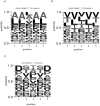Analyses of the Sequence and Structural Properties Corresponding to Pentapeptide and Large Palindromes in Proteins
- PMID: 26465610
- PMCID: PMC4605511
- DOI: 10.1371/journal.pone.0139568
Analyses of the Sequence and Structural Properties Corresponding to Pentapeptide and Large Palindromes in Proteins
Abstract
The analyses of 3967 representative proteins selected from the Protein Data Bank revealed the presence of 2803 pentapeptide and large palindrome sequences with known secondary structure conformation. These represent 2014 unique palindrome sequences. 60% palindromes are not associated with any regular secondary structure and 28% are in helix conformation, 11% in strand conformation and 1% in the coil conformation. The average solvent accessibility values are in the range between 0-155.28 Å2 suggesting that the palindromes in proteins can be either buried, exposed to the solvent or share an intermittent property. The number of residue neighborhood contacts defined by interactions ≤ 3.2 Ǻ is in the range between 0-29 residues. Palindromes of the same length in helix, strand and coil conformation are associated with different amino acid residue preferences at the individual positions. Nearly, 20% palindromes interact with catalytic/active site residues, ligand or metal ions in proteins and may therefore be important for function in the corresponding protein. The average hydrophobicity values for the pentapeptide and large palindromes range between -4.3 to +4.32 and the number of palindromes is almost equally distributed between the negative and positive hydrophobicity values. The palindromes represent 107 different protein families and the hydrolases, transferases, oxidoreductases and lyases contain relatively large number of palindromes.
Conflict of interest statement
Figures







Similar articles
-
A tale of two symmetrical tails: structural and functional characteristics of palindromes in proteins.BMC Bioinformatics. 2008 Jun 11;9:274. doi: 10.1186/1471-2105-9-274. BMC Bioinformatics. 2008. PMID: 18547401 Free PMC article.
-
Amino acid conformational preferences and solvation of polar backbone atoms in peptides and proteins.J Mol Biol. 2000 Jul 28;300(5):1335-59. doi: 10.1006/jmbi.2000.3901. J Mol Biol. 2000. PMID: 10903873
-
A hydrophobic spine stabilizes a surface-exposed α-helix according to analysis of the solvent-accessible surface area.BMC Bioinformatics. 2016 Dec 22;17(Suppl 19):503. doi: 10.1186/s12859-016-1368-z. BMC Bioinformatics. 2016. PMID: 28155647 Free PMC article.
-
Nonrandom clusters of palindromes in herpesvirus genomes.J Comput Biol. 2005 Apr;12(3):331-54. doi: 10.1089/cmb.2005.12.331. J Comput Biol. 2005. PMID: 15857246 Free PMC article. Review.
-
Computational protein design: a review.J Phys Condens Matter. 2017 Apr 12;29(14):143001. doi: 10.1088/1361-648X/aa5c76. Epub 2017 Jan 31. J Phys Condens Matter. 2017. PMID: 28140371 Review.
Cited by
-
WAS IT A MATch I SAW? Approximate palindromes lead to overstated false match rates in benchmarks using reversed sequences.Bioinform Adv. 2024 Apr 8;4(1):vbae052. doi: 10.1093/bioadv/vbae052. eCollection 2024. Bioinform Adv. 2024. PMID: 38764475 Free PMC article.
-
Probing Protein Folding with Sequence-Reversed α-Helical Bundles.Int J Mol Sci. 2021 Feb 16;22(4):1955. doi: 10.3390/ijms22041955. Int J Mol Sci. 2021. PMID: 33669383 Free PMC article.
References
-
- Ohno S (1992) Of palindromes and peptides. Hum Genet Dec 90:342–5. - PubMed
-
- Ohno S (1993) A song in praise of peptide palindromes. Leukemia 2:S157–9. - PubMed
-
- Marcin Hoffmann, Jacek Rychlewski (1999) Searching for palindromic sequences in primary structure of proteins. Computational Methods in Science and Technology 5: 21–24.
-
- Giel-Pietraszuk M, Hoffmann M, Dolecka S, Rychlewski J, Barciszewski J (2003) Palindromes in proteins. J Protein Chem 22:109–13. - PubMed
MeSH terms
Substances
LinkOut - more resources
Full Text Sources
Other Literature Sources

